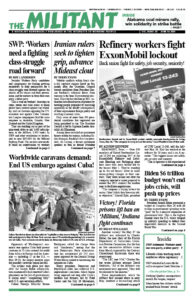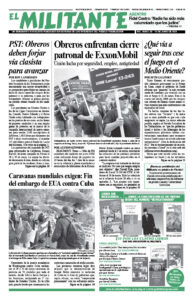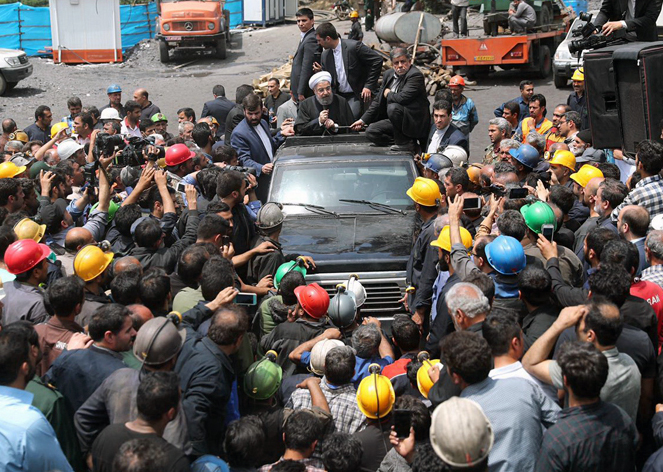Volatile conflicts within Iran’s cleric-led capitalist regime flared up this month after the Guardian Council barred candidates from President Hassan Rouhani’s reformist forces from running in the June 18 presidential elections. Since the last election in 2017, authorities have faced waves of protests by working people propelled by mounting opposition to the deadly consequences of their expansionist foreign policy and resulting economic crisis.
Only seven of more than 590 presidential candidates that registered are being permitted to run. The Guardian Council is led by Supreme Leader Ayatollah Ali Khamenei.
Among those excluded are prominent figures within the regime, including Eshaq Jahangiri, Rouhani’s first vice president; Ali Larjani, a former parliament speaker; as well as former President Mahmoud Ahmadinejad, a frequent critic of the government. Rouhani has been in office since 2013 and by law cannot seek a third term.
“What the Guardian Council did … has made elections meaningless,” Azar Mansouri, a spokesperson for the Iran Reformists Front, told the Financial Times. Khamenei condemned calls made by capitalist opposition groups for a boycott of the vote.
The decision ensures that a conservative candidate closely aligned with Khamenei and his Islamic Revolutionary Guard Corps allies will win the election. Ebrahim Raisi is the front-runner. Backed by both Khamenei and the Revolutionary Guard, he ran in the 2017 election, but was soundly defeated by Rouhani.
Decision-making on key questions, including foreign policy, remains in the hands of Supreme Leader Khamenei, not the president.
In addition to being a military and repressive force, the Revolutionary Guard runs many of the largest, most profitable industries in the country.
All wings of the regime, including disqualified presidential candidates, back the Iranian rulers’ assaults on working people at home and their interventionist foreign policy abroad. Tehran seeks to export its counterrevolutionary policies throughout the region. That course has brought it into sharper conflict with working people in Iraq, Lebanon and Syria, as well as in Israel. Moreover, the human and financial toll of these conflicts is borne at home by workers and farmers and has eroded any moral legitimacy claimed by Iran’s rulers and their state.
The Iranian rulers have intervened in bloody conflicts across the Middle East, entrenching militias and weapons bases to extend their power. This included supplying weapons-making material to Hamas in the Gaza Strip that it used in the thousands of recent rocket attacks launched on Israel.
The 1979 Iranian Revolution
Iran’s workers and farmers carried out a popular revolution that overthrew the dictatorial rule of the U.S.-backed shah. Workers councils were set up in factories and oil refineries across the country, gains were made in the fight for the national rights of the Kurds and other oppressed peoples, and in the fight for the emancipation of women.
The Iranian rulers’ expansionist course was part of their moves to drive through a far-reaching counterrevolution against these advances. Capitalist politicians of all stripes in the U.S. present the Tehran regime’s counterrevolution as if it is the revolution itself.
In 2019 up to 1,500 people were shot and killed by Iranian security forces and paramilitary squads during country-wide protests against the regime. Widespread demonstrations had begun in 2017 as working people took advantage of widening divisions within the regime. For factional reasons, Rouhani had released some of the facts about the authorities’ vast spending on the Revolutionary Guard and other military forces, hoping to deflect anger away from his administration’s cuts to subsidies on basic necessities that millions depend upon.
This year’s election takes place after years of U.S. sanctions have sharply exacerbated the impact of the economic crisis bearing down on working people in Iran, widening class inequalities. On May 23 the semiofficial government news agency ISNA reported the prices of six basic food items had increased 70% since the end of March.
President Joseph Biden’s administration and Iran’s rulers have begun talks aimed at reviving the 2015 nuclear deal Washington struck with Tehran, in exchange for cutbacks in sanctions.
As part of its negotiating tactics, Tehran announced last month it was enriching uranium to levels far above those agreed to in the 2015 deal. Since that pact was reached Tehran has also expanded its deployment of precision missiles, rockets and drones to allies across the region.
The clerical regime aims to use the elections to push back the ongoing popular opposition, to continue to extend its reach abroad, and to strengthen its hand in its conflict with Washington.


